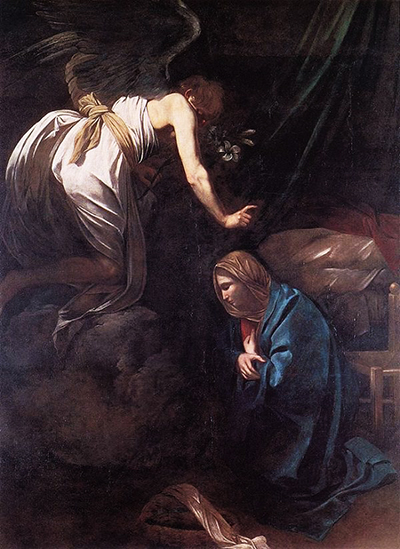The Annunciation is an oil-on-canvas painting masterpiece by Michelangelo Merisi da Caravaggio, a renowned Italian artist and painter.
Finished in 1608, the painting has its shelter at the Musee des Beaux-Arts de Nancy. The Annunciation has withstood the test of time, though it has been reworked and retouched several times. Nevertheless, Caravaggio’s brushwork still lingers, determined to carry the artist’s message into the next century.
The artwork depicts two figures, a human and a non-human as the other image seems to have wings. The person, apparently a lady, is bowing before the winged creature, an angel, who appears to be delivering a message from the deity. The angelic member floats on a cloud while the woman kneels in supplication on the floor.
This painting is more baroque than would be the case for Caravaggio. However, the heavenly messenger assumes a powerful pose that renders the woman into a receptive posture, creating a powerful impact on the audience.
Biblical Perspectives
Caravaggio must have had a soft spot for Biblical impressions. The figure with wings is, of course, the angel Gabriel, delivering the message of a perfect pregnancy to the supplicating woman, Mary. The angel holds lilies in his hand, a clear indication that the recipient of the divine message is a virgin.
Virgin Mary would later conceive and give birth to Jesus Christ, the Son of God. The painting seems to reflect Caravaggio’s religious tendencies which include the belief in angels as messengers of the Supreme Being above.
The picture is an implication of the important role angels plays in the lives of ordinary people. Except for the two beings in the artwork, the rest of the painting is black. The angel, therefore, brings some form of illumination to the dark life of Mary, and by extension the whole worlds that are in need of a redeemer.
The place of women in society
Caravaggio lived at a time when women couldn’t hold a position of honour in the society, but it could not stop him from attaching importance to the females in his artworks. In this particular painting, the angel chooses to appear to a woman rather than a man to fulfill the divine mission. It was perhaps easier to deliver the message to a female who would be ready to prostrate and obey more than a man who may have had the guts to question things. The artist strives to redeem the image of women by placing them at the core of religion and spirituality in human existence.
Caravaggio’s Annunciation is a powerful depiction of the Biblical incident in which the angel visited the Virgin Mary to deliver God’s plans for her. It portrays two beings, the angel Gabriel and Mary against a dark background. Painted in 1608, the artwork has stood the challenging test of time and still bears Caravaggio’s original brushwork.




